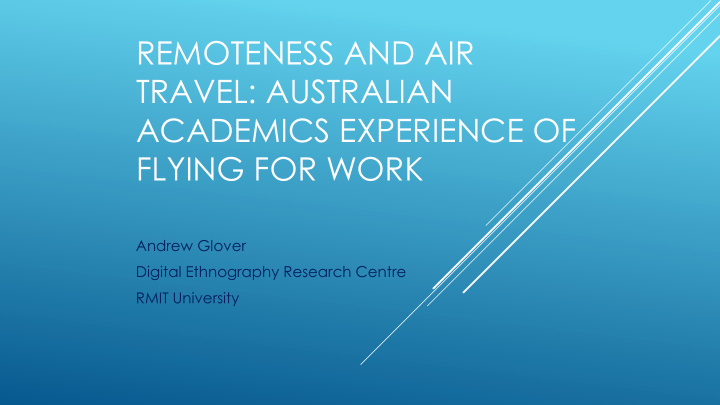



REMOTENESS AND AIR TRAVEL: AUSTRALIAN ACADEMICS EXPERIENCE OF FLYING FOR WORK Andrew Glover Digital Ethnography Research Centre RMIT University
CONTEXT
GUIDING RESEARCH QUESTIONS What role does air travel play in academic life? What are Australian universities doing about the environmental impact of academic air travel? What alternative forms of academic practice might allow us to fly less?
HOW MUCH DO ACADEMICS FLY? Number of Flights in the last 12 months In the past year, 35 Australian academics took, on average: 30 3 domestic return Percentage of respondents 25 flights, AND 20 1.7 international return flights 15 10 Does not include non-work related flights 5 0 7 8+ 4 5 6 0 1 2 3
Q: What are your primary reasons for undertaking work-related air travel? Attending academic conferences, symposia, workshops Attending industry events Undertaking fieldwork/ data collection Meetings with other academics Meetings with industry Commuting Other I don’t undertake air travel 0 30 40 50 60 70 80 90 100 10 20 Percentage of respondents
Q: How necessary is work-related air travel to your ongoing academic career? Extremely necessary Somewhat necessary Neither necessary or unnecessary Somewhat unnecessary Extremely unnecessary 70 0 10 20 30 40 50 60 Percentage of respondents
PERCEIVED IMPORTANCE OF AIR TRAVEL “Without it, your research will be ignored . You need to show your work at major conferences, and build collaborative networks .” “Need to meet and network with international colleagues and be seen in order to get invited to co-write papers, be part of symposia, co-submit grants… All this is necessary to build international collaborations .” “Without ongoing active collaboration , without exposure , and without quality communication, my academic career would collapse .”
WHY DO THESE INTERACTIONS NEED TO BE FACE-TO-FACE? “Face to face engagement with colleagues is very important for academics in regional Australia to reduce their feelings of isolation and to promote productive research publication output. I do attend Skype and GOTO meetings online but one does not get the same level of engagement as one does face to face.” “ Nothing is as good as for building international links and research networks as face-to- face meeting” “ Personal contact cannot be substituted with emails.”
DOMESTIC REMOTENESS “Most of the peers in my field are located in, or in close proximity to metropolitan centers. Being in a regional center means flying to Sydney as a first step and if the location of the event is in a place other than Sydney, then one has to take at least one additional flight.” “Townsville is near NOTHING. The vast majority of academics are in Victoria / NSW and I usually need two flights to visit for conferences and meetings.”
DOMESTIC REMOTENESS “Melbourne is a major Australian city that is well connected and is also a destination that many national and international colleagues are drawn to, sometimes negating the need for me to travel .” [Melbourne based Senior Research Fellow, Research Only, Female, Studies in Human Society] “We are a research ‘hotspot’ in my field – so many of our domestic colleagues come to us ! I think we do less domestic travel than similar academics because of this.” [Brisbane, Male, Full-Time, Research Fellow, Physical Sciences] “Being in Sydney, most of my direct collaborators are within driving distance .” [Sydney, Female, Full Time, Lecturer, Research and Teaching, Physical Sciences]
INTERNATIONAL REMOTENESS “I live in the most isolated city in the world with few opportunities for collaboration and engagement with colleagues in my or related discipline. I’m very envious of colleagues in Europe where there are a large number of affordable and scholarly activities available that are only a short drive/train/ plane ride away” “My research is primarily carried out internationally (Europe/US/Asia), hence scientific meetings are usually located internationally… The research in my domain requires a substantial level of currency and international coordination, therefore conferences and meetings are the most suitable form of dissemination and cross-fertilization .”
WHAT IS DRIVING THE NEED FOR AIR TRAVEL? Other policies undermine air travel reduction, e.g. Internationalization strategies → targeting lucrative international student markets Research academics → international research collaborations & publications “ RMIT – Global, Urban, Connected ”; “Deakin: Worldly” Institutional orientations = strong implicit requirement for air travel 13
NEW FORMS OF CONFERENCING ‘No Fly’, ‘Low Carbon’, ‘Virtual’ Conferences increasingly common Evolving formats from traditional conferences
TELEPRESENCE ROBOTS Wheel based devices with electric motor Remotely controlled over wifi Camera, microphone, speaker, screen Operated via app or browser window Controlled with smartphone or keyboard
DIGITIZATION OF ‘ANALOGUE’ CONFERENCES Telepresence Robots (CHI 2017) • 18
FUTURE CONFERENCING ‘Chameleon Mask’
THANKS FOR LISTENING https://worklifeecologies.org/
Recommend
More recommend